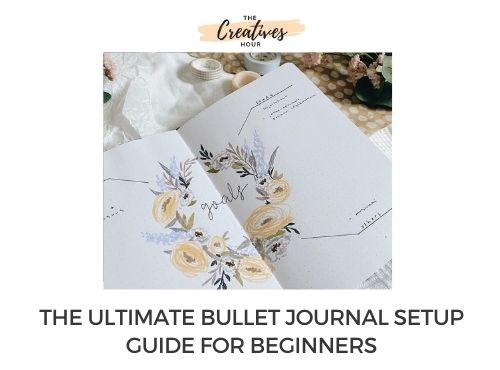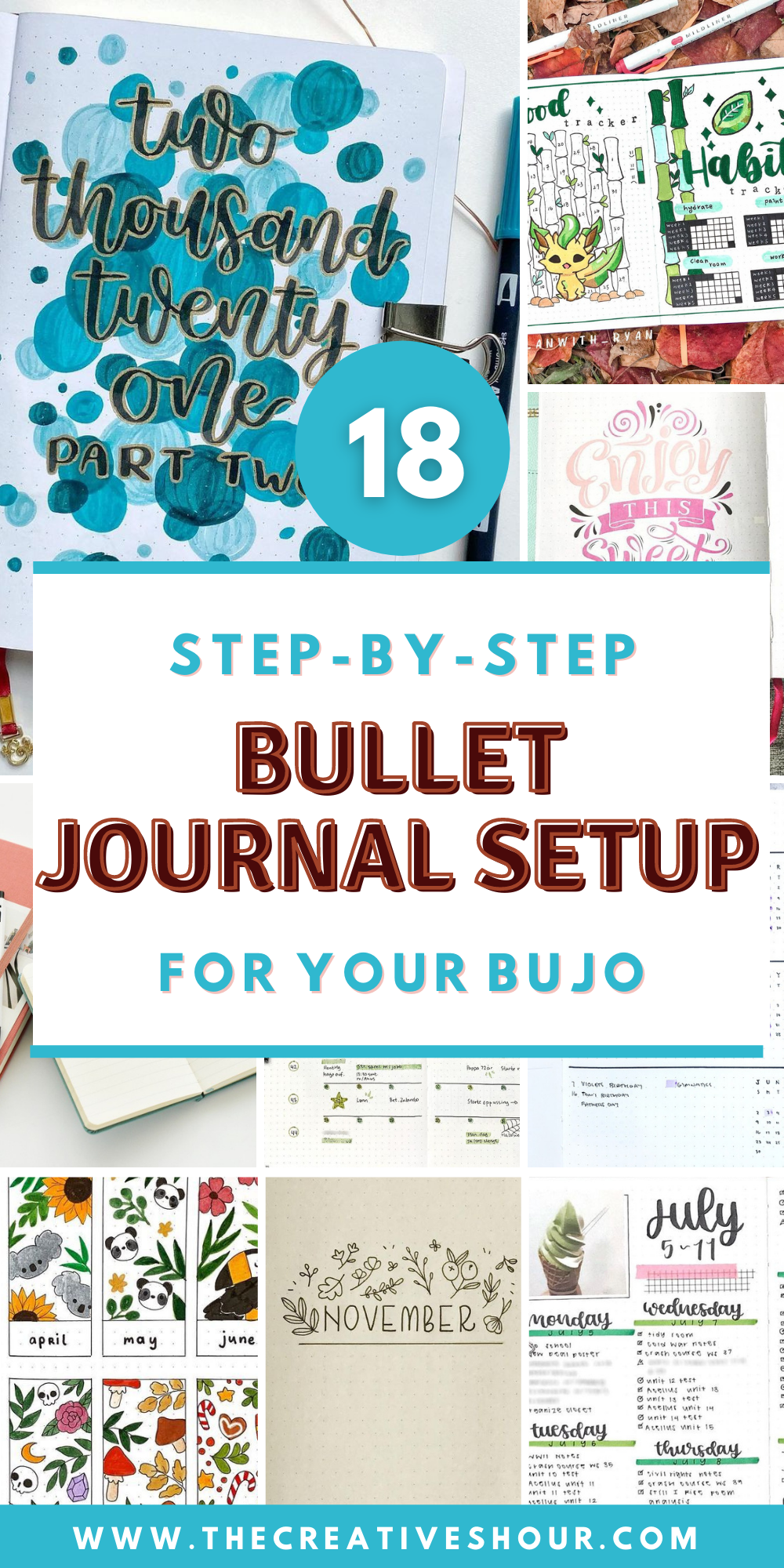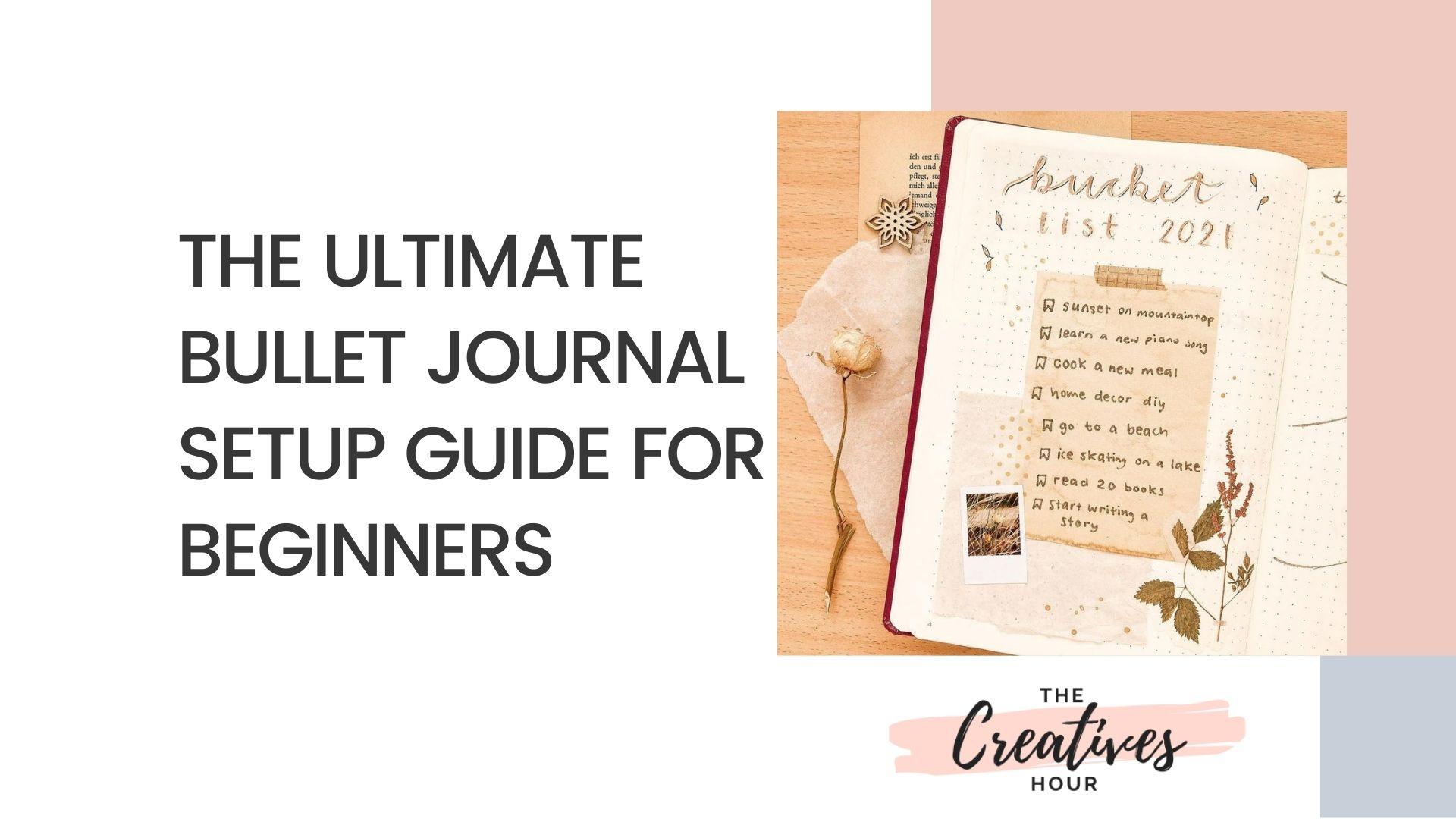
Source: tabea.journal
Are you thinking of setting up a bullet journal but don’t know where to start? Keep reading because this bullet journal setup guide has simple answers to all your confusing questions! It is a perfect read for anyone starting a new bujo, migrating to a new notebook, or setting up a fresh one for the new year! The flexibility of a bullet journal can seem intimidating with tons of options to choose from. But once you are done reading this post, you’ll have a clear idea of what you want from your journaling experience. So, you can finally get beyond that first-page fear with these easy bujo tips!
Tips for a Good Bullet Journal Setup
Before we move on to setting up your bullet journal, here are some supplies and tips you need to get started. Make sure to check this list off before heading to the next step.
Choose good quality supplies
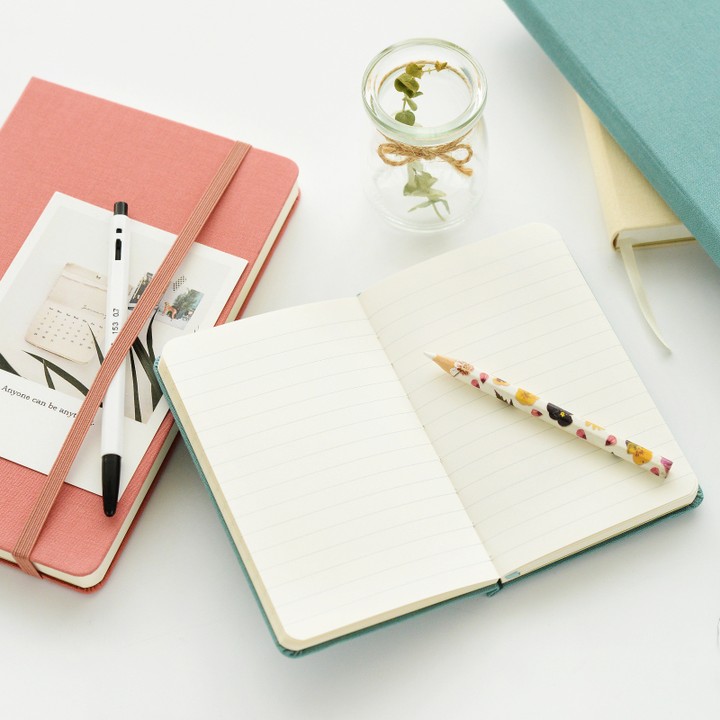
Source: bujomarks
Bullet journaling can be anything from a super basic to a super creative process. It all depends on how you want your bujo to look and feel. But the basic supplies you need to begin are a notebook and a pen. That’s all! You can use any old notebook, half-used composition notebook, or even a pocket pad. If you want a more exclusive experience, you can upgrade to a dot-grid notebook as well.
As for the writing tools, you can opt for any of your favorite pens. A basic black pen, colored pens, or a combination of the two works great! You can use some pastel highlighters for adding pens, or a combination of the two works great! You can also use some pastel highlighters for colorful and organized journal spreads.
Check out our post on the best bullet journal supplies to choose the best ones for yourself!
Be okay with trial and error.
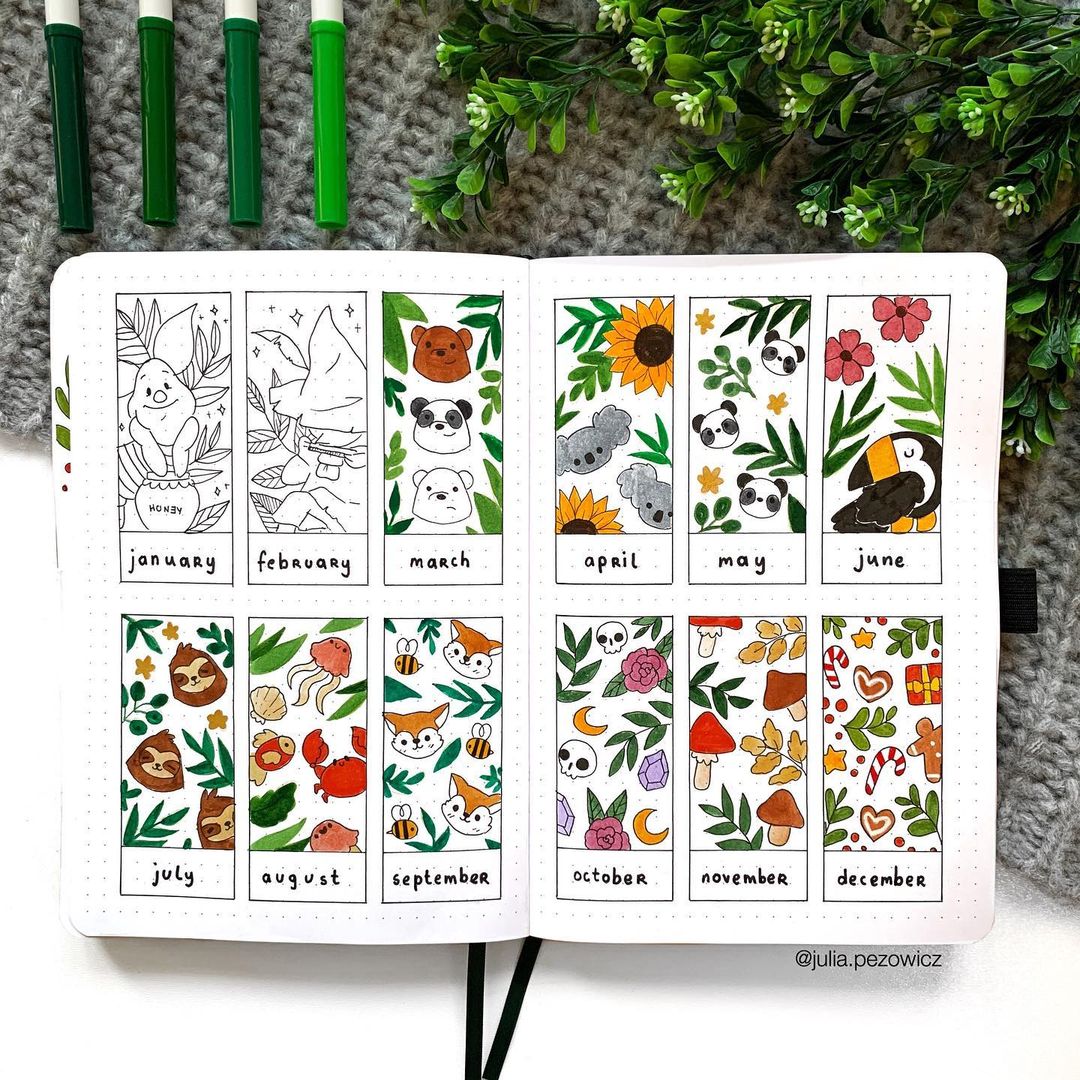
Source: julia.pezowicz
When you begin bullet journaling, choosing spreads can be a confusing task. With so much space for customization, where do you start? How do you make sure you chose the right spread?
The answer is through trial and error. This guide provides you with basic spreads and some must-haves in your bujo. However, there are multiple possibilities in this process, and you will gradually discover what works best for you!
Maintain the index page
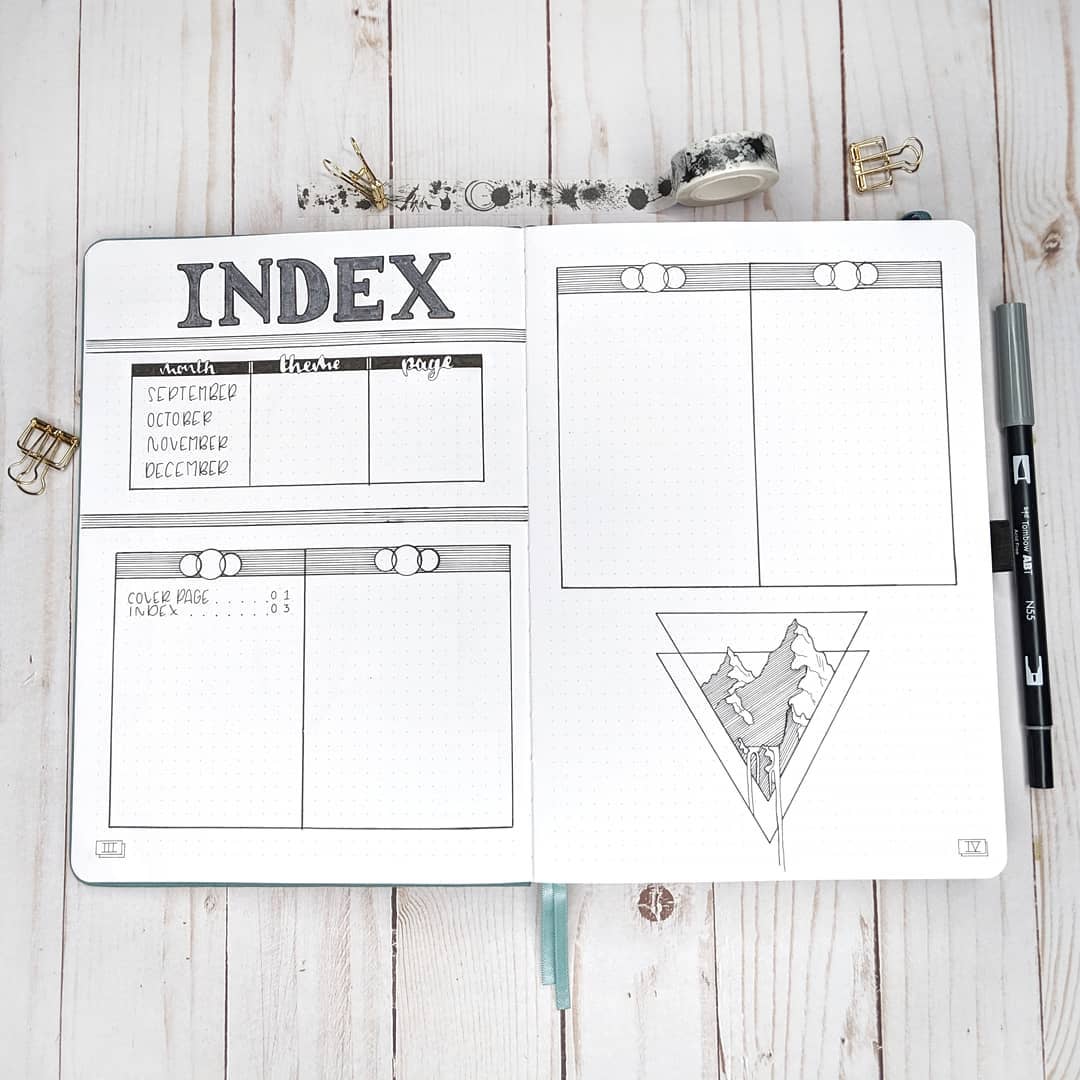
Source: arkjournals
This tip might sound boring and hard to maintain. But, it will really be helpful in the long run when you look back at your bullet journal trying to find a particular page. If you want the work to be hassle-free, opt for a basic index layout with the topic and page number.
Don’t overdo designs.
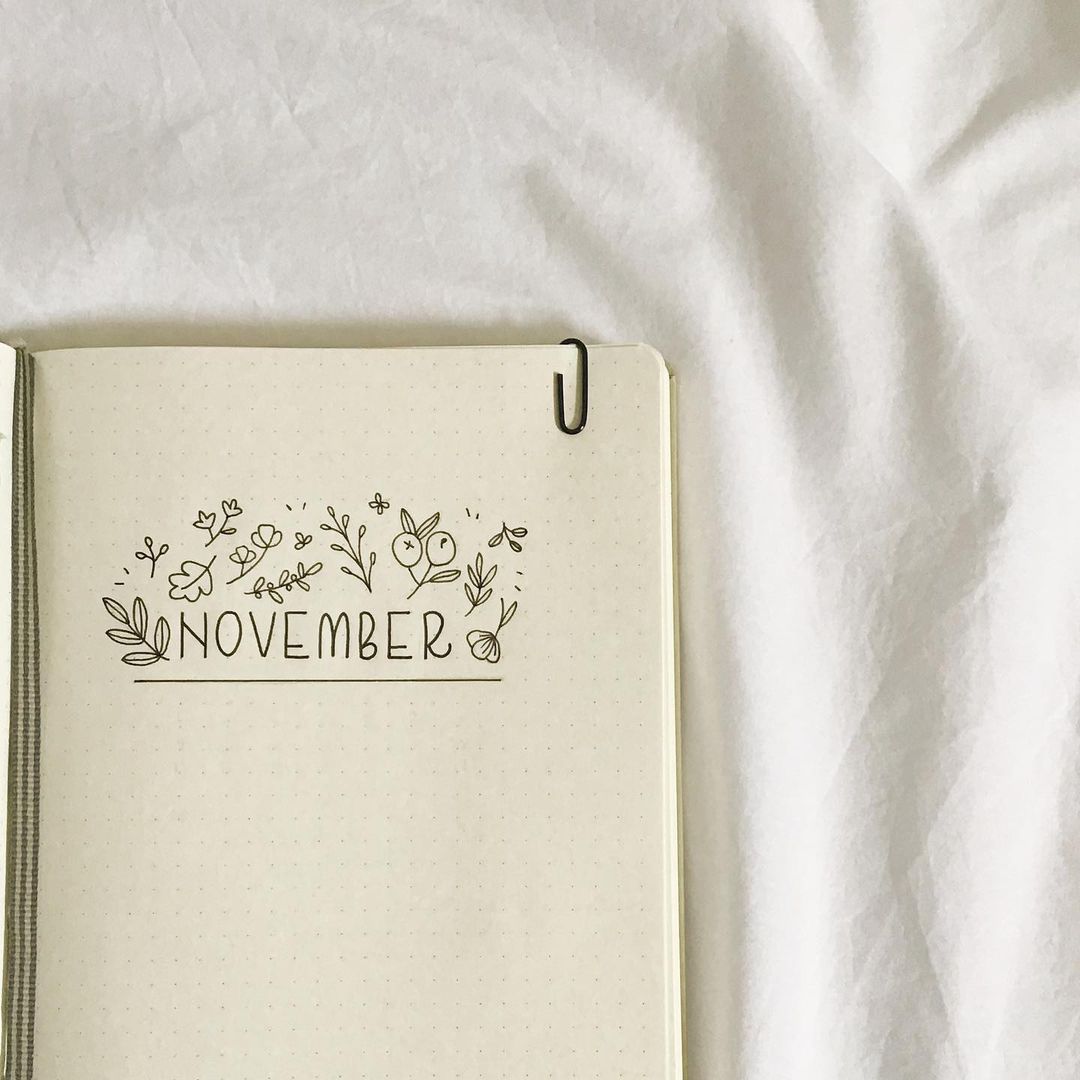
Source: pagesbymaria
Bullet journals are a blank canvas for you to get as creative as you want. But, don’t let a creativity block prevent you from beginning your journaling. If you are not in the artsy zone, it’s okay to go simple and minimal. Also, don’t worry, the first few pages of your bujo will never be the best ones, so just keep going!
Step-by-Step Guide For Setting Up Your Bullet Journal
Now that you have grabbed your favorite supplies and are free of any worries, it’s time to start setting up your bullet journal. This section is a step-by-step guide to setting your bujo pages from the cover page to the trackers.
Step 1 – Cover Page
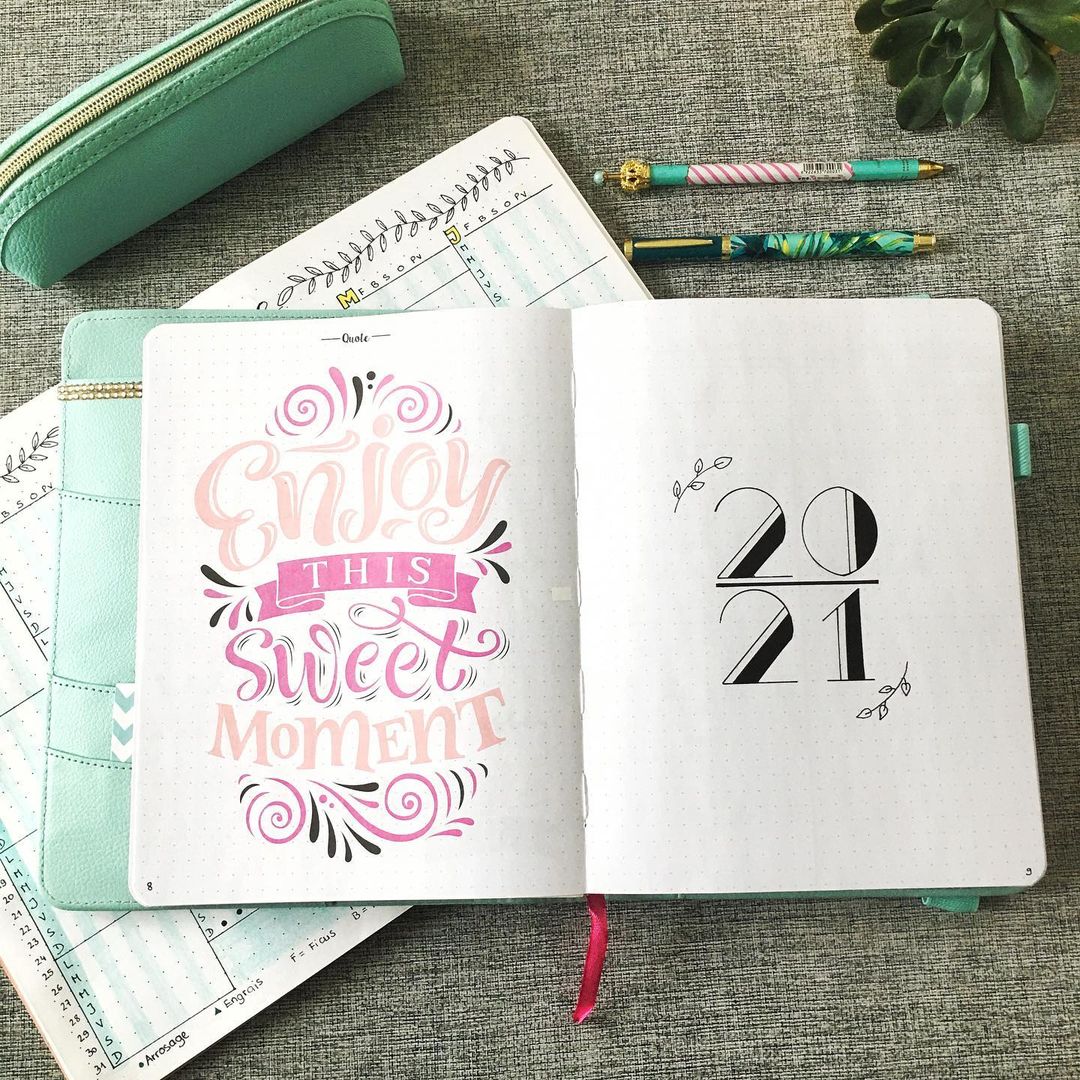
Source: douces.inspirations
Your first step at being super creative is through the bullet journal cover page. It’s a fun, colorful, and exciting way to begin your journal. Try to make this page as inspiring and attractive as you can since you’ll be welcomed by it every time you sit down to journal.
Cover pages can be designed in tons of ways. You can choose to write the year you start the journal in to give those musings a time frame.
Here are some ideas for your cover page:
- Year when you begin the journal
- Theme related doodles
- Detailed, creative illustrations
- An inspiring quote
- Unique Patterns
Step 2 – Key
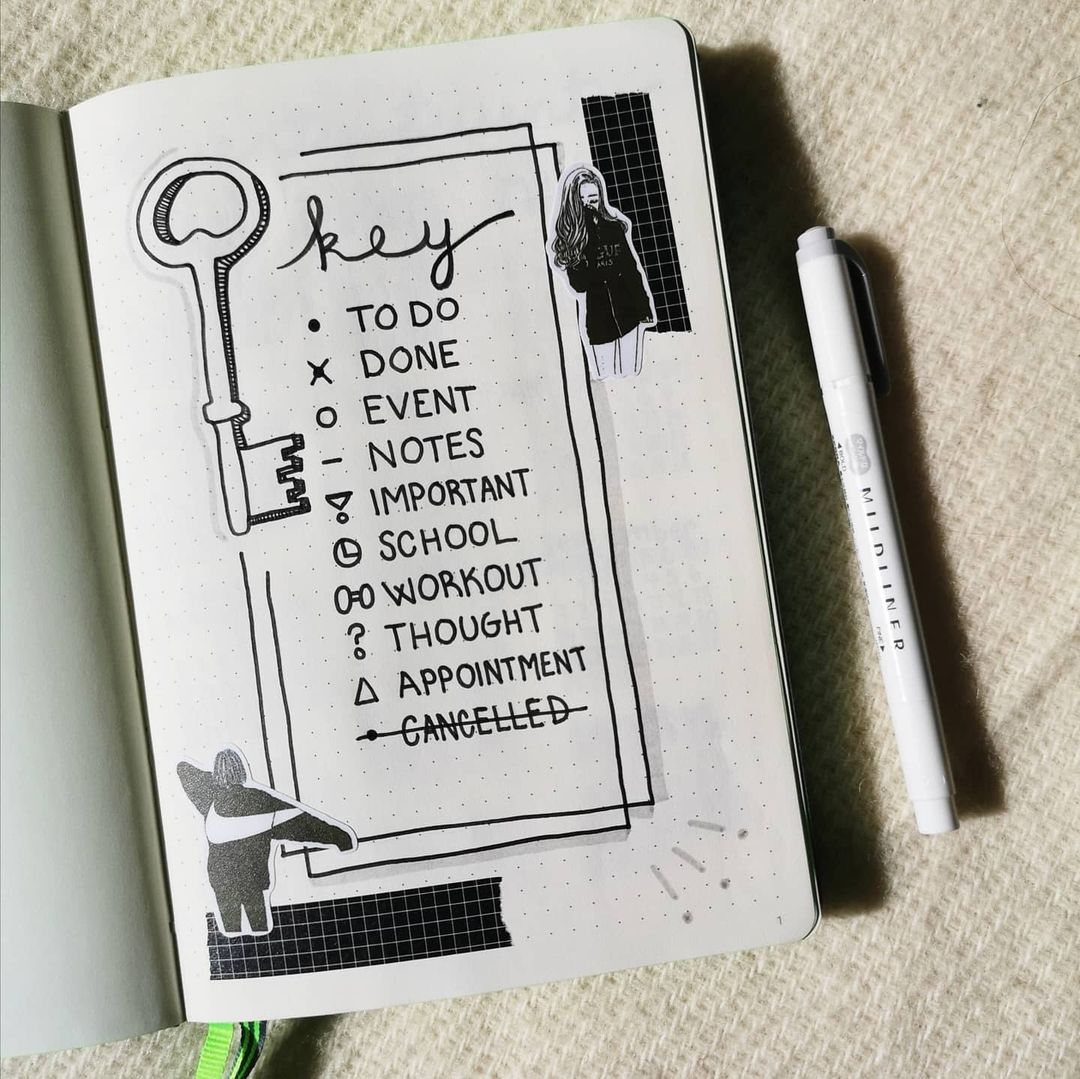
Source: emmadbujo
A key page is a place where you list the symbols that you’ll use for rapid logging. You have to assign different symbols for different things. For instance:
- a “□” or check-box for tasks or to-do lists. You can cross out or fill the box once the task is finished.
- a “-” for events, appointments, or meetings.
- a “•” for things to remember.
- a “*” or asterisk next to important or priority items.
These signifiers allow you to glance across any page of your bujo and quickly spot what you are looking for. There are multiple symbols that you can use, so select what’s best for you! Adding a key page would help you organize all the signifiers that you’ll use throughout your bujo! For more information on bullet journal keys, check out these bujo key ideas.
Step 3 – Index
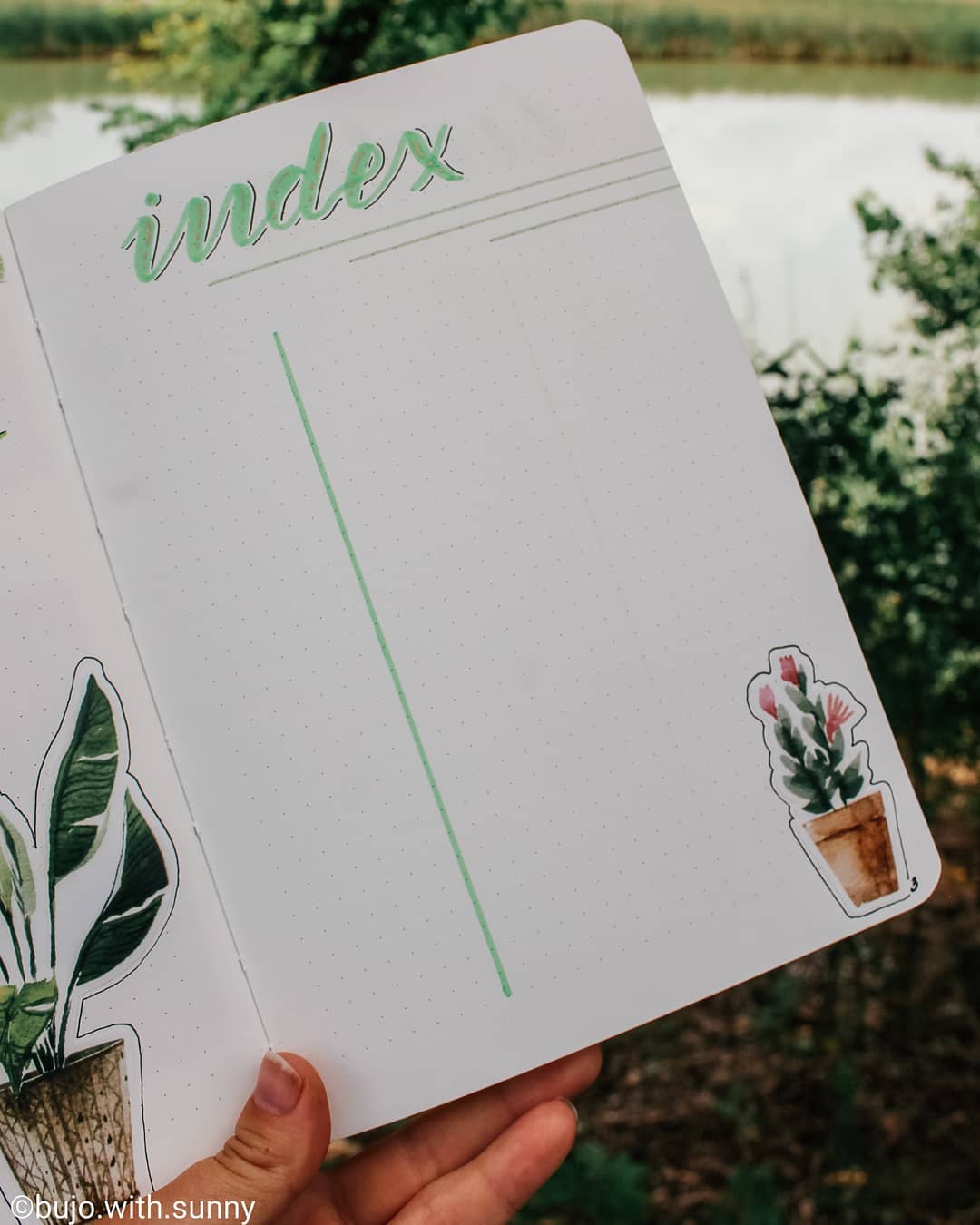
Source: sunsplan
An index or a table of contents is another must-have spread in your bujo. It acts like a map for small yet essential information that you write in your journal. While creating this page, make sure to leave ample space to log all entries of the journal. Try leaving at least three pages.
It is also important that your bujo notebook has numbered pages for easy logging. If the pages are not numbered, make sure you number each page before working on it. It sounds quite cumbersome, but it’s going to be worth the time! Here are some bullet journal index page ideas to help you out.
Step 4 – Future log
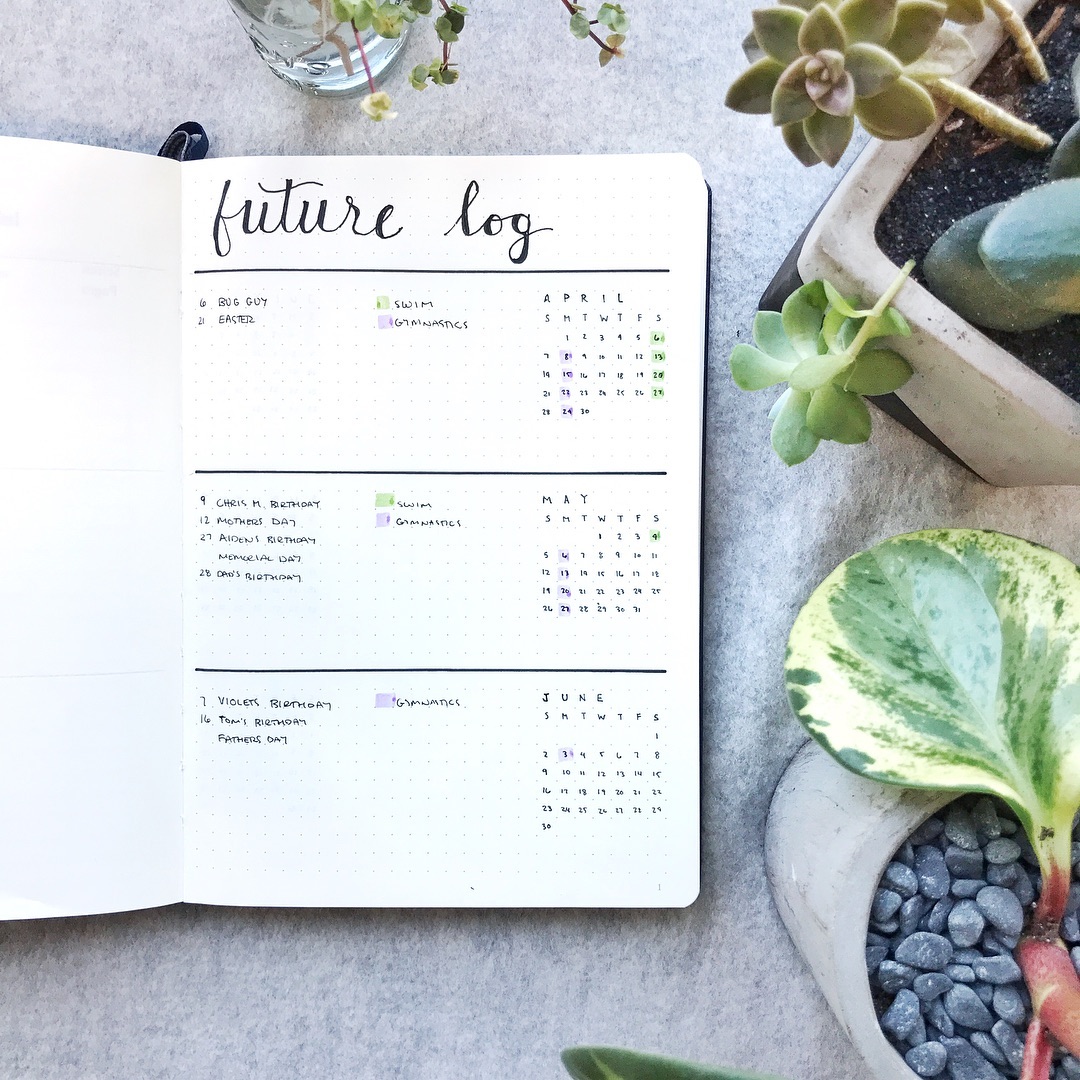
Source: menwhobullet
A future log is a calendar-like space for you to jot down all important upcoming events. These can include
- birthdays,
- anniversaries,
- vacations,
- business trips,
- national holidays, or
- any other relevant dates
This allows you to create an overview of your year and provides space to list down the descriptions or reminders for the events. The future log doesn’t necessarily have to be for the entire year; you can customize it just like every page in your bullet journal. Here are future log ideas for planning your year.
Step 5 – Monthly log
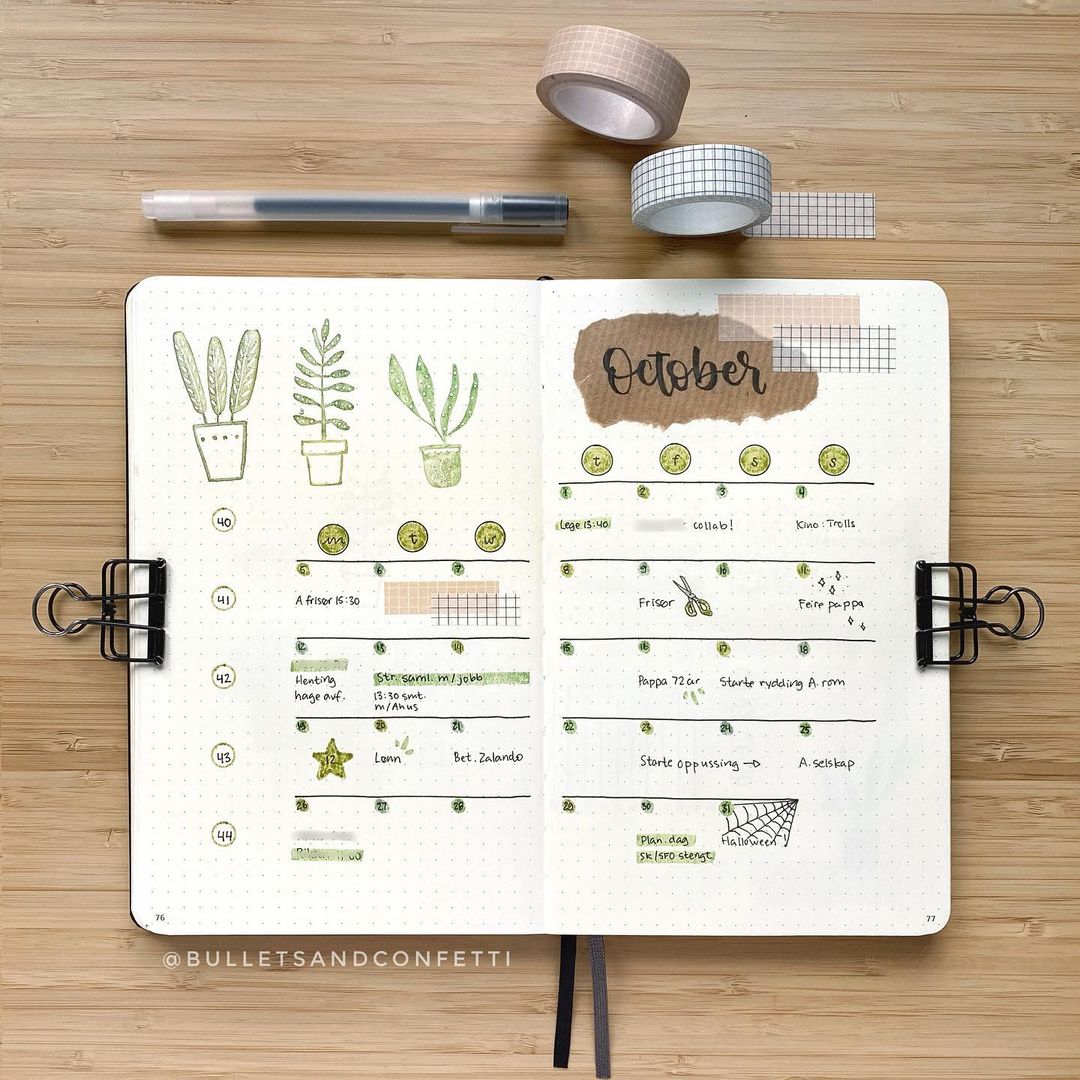
Source: bulletsandconfetti
The next step is setting up the monthly log. This is a space for you to plan all the things for each month and create a monthly overview. You can also add a to-do list for every month.
Another thing you can add your creative touch to is a monthly cover page. This helps separate your monthly spreads and adds to the theme you have chosen for the month or the journal. Lastly, your artsy touch makes the spread personalized, attractive, and something you can proudly show off! Here are some monthly spread ideas to help you create your first month log.
Step 6 – Weekly Spread
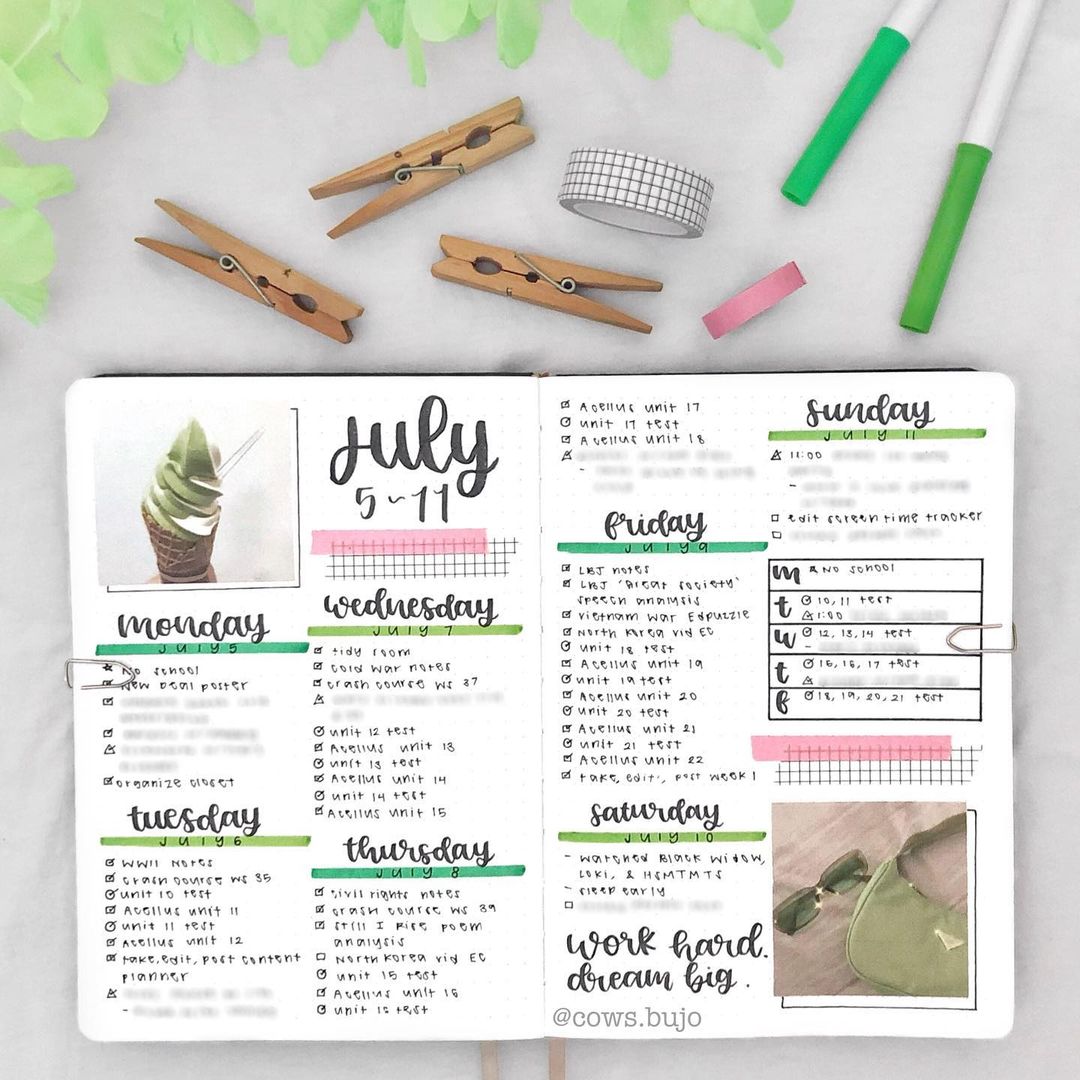
Source: cows.bujo
We are finally down to the last must-have spread of your bullet journal — a weekly spread or daily log. This spread is an overview of your week with sections for each day. You can create daily to-do lists, set daily appointments/reminders, etc. If you have lots of work each day that requires organized tracking, a daily log is a must for your bullet journal. Discover some of the best bullet journal weekly spread ideas here to help you find one that best suits your needs.
Extra spreads for your bullet journal
The above section describes a list of some basic and must-have spreads. However, a few more helpful spreads will be a beneficial addition to your bullet journal.
1. Goals Page
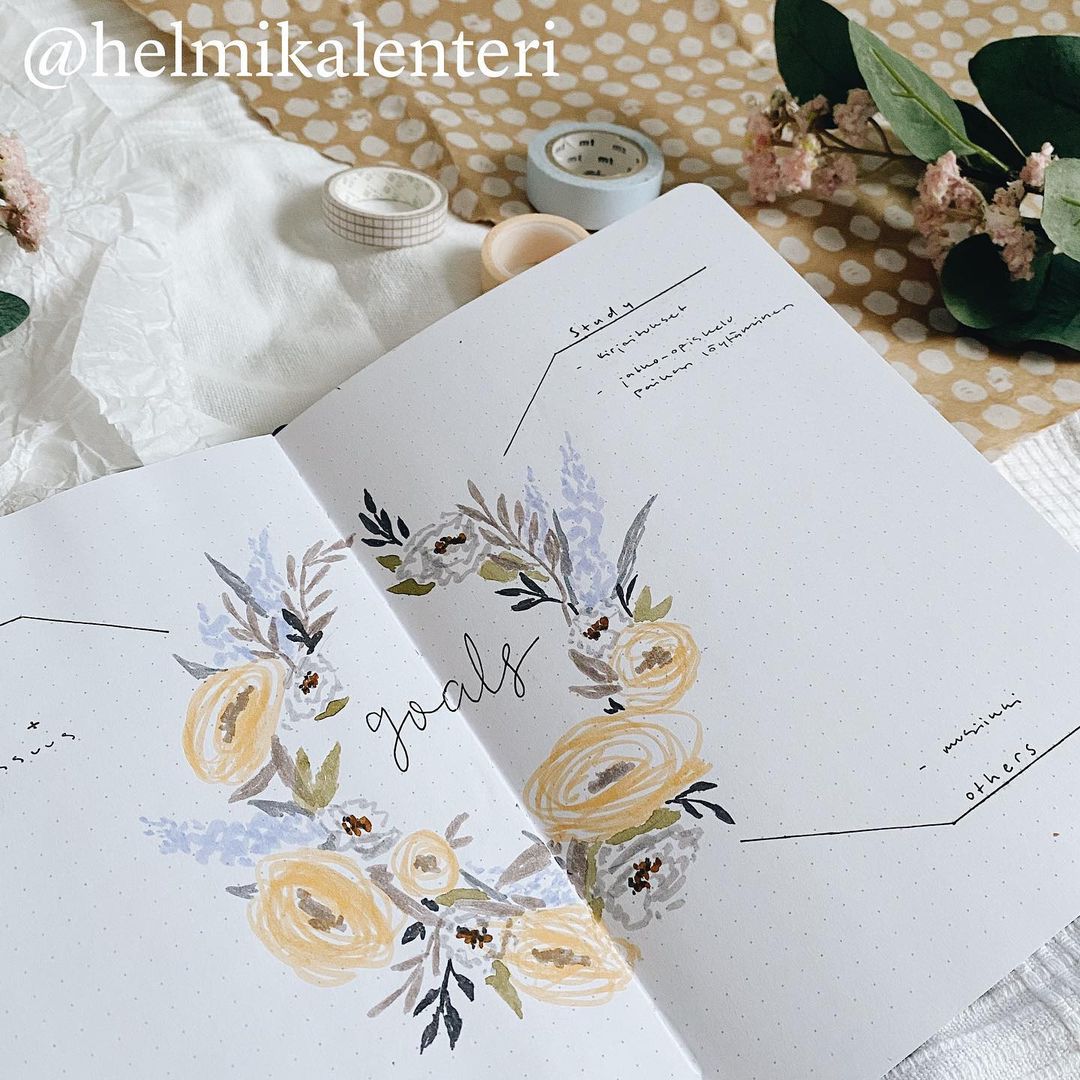
Source: helmikalenteri
If you are creating a yearly bullet journal, a goals page is a very beneficial addition. It helps you set targets, improve your life, and achieve your dreams. These goals don’t necessarily have to be long-term; you can also add your short-term targets to this spread!
There are multiple ways of creating a goals page; you can design whatever suits your needs. Do check out our post on goals page ideas for more inspiration.
2. Trackers (Habit, Sleep, Mood, Fitness)
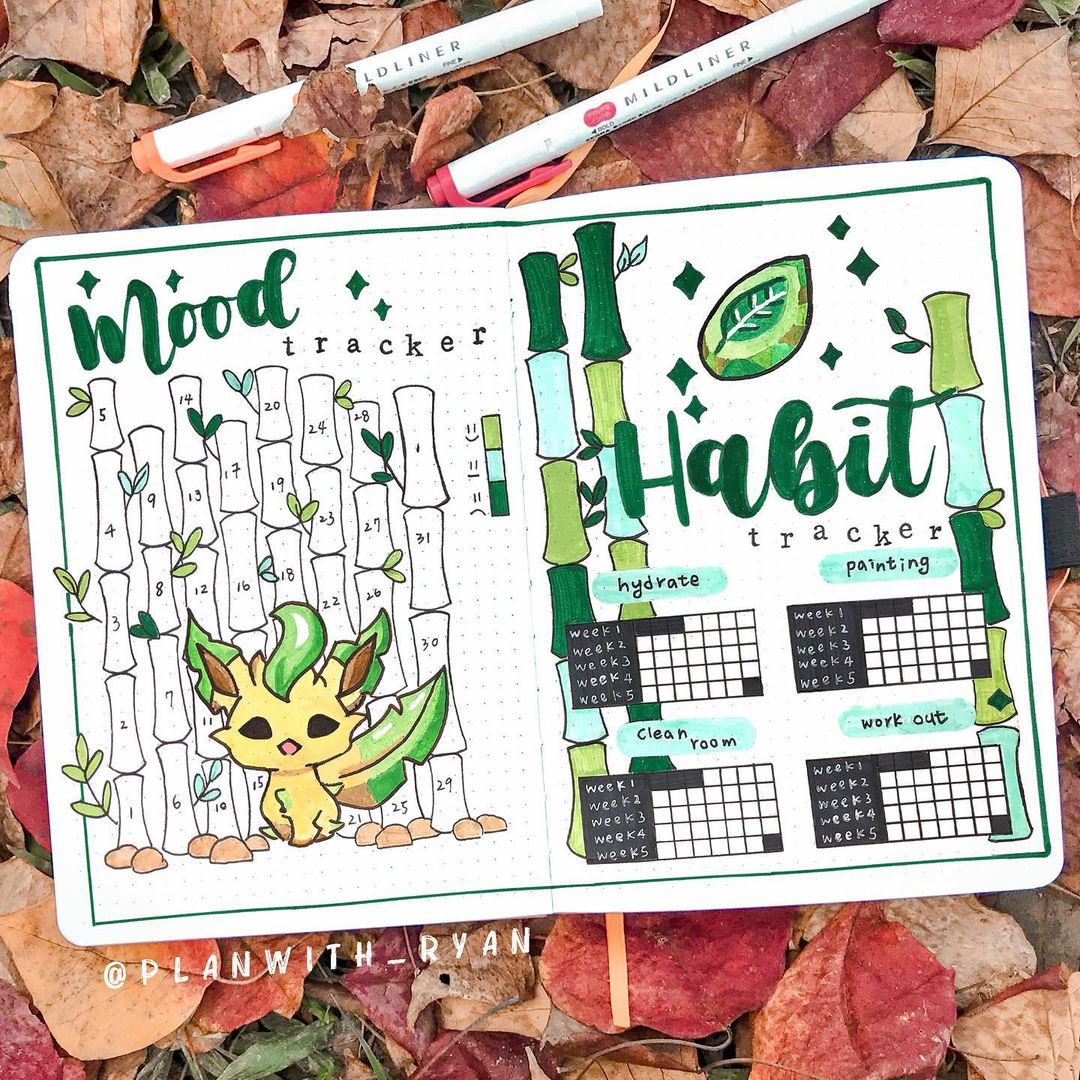
Source: planwith_ryan
Another spread that is a fun, interesting, and creative addition to your bullet journal is a tracker. There are multiple trackers that can help you in learning your lifestyle patterns and improving them. These are also an excellent way of developing better routines.
Here are some trackers that you can add to your bujo:
- Habit Tracker: a monthly spread of different habits that you want to keep a check on. These can include exercising, reading habits, practicing hobbies, etc.
- Skincare Tracker: a monthly spread for keeping a track of your skincare habits, such as cleansing, toning, face masking, moisturizing, etc.
- Health Tracker: a tracker for checking your healthy habits including drinking water, taking vitamins, exercising, controlling junk food, etc.
- Mood Tracker: this tracker is a great way to assess your moods throughout the month. It helps you keep a check on your mental health as well!
- Sleep Log: if you are trying to get your sleep cycle back to normal, a sleep log is a must-have. Tracking your sleeping habits will help you get enough hours of sleep regularly.
- Birthday Tracker: you’ll never forget to wish your loved ones if you have a birthday tracker added to your bullet journal!
- Period Tracker: tracking your period cycle is important for your health and a period tracker is a fun and creative way of doing it!
3. Finance Layout
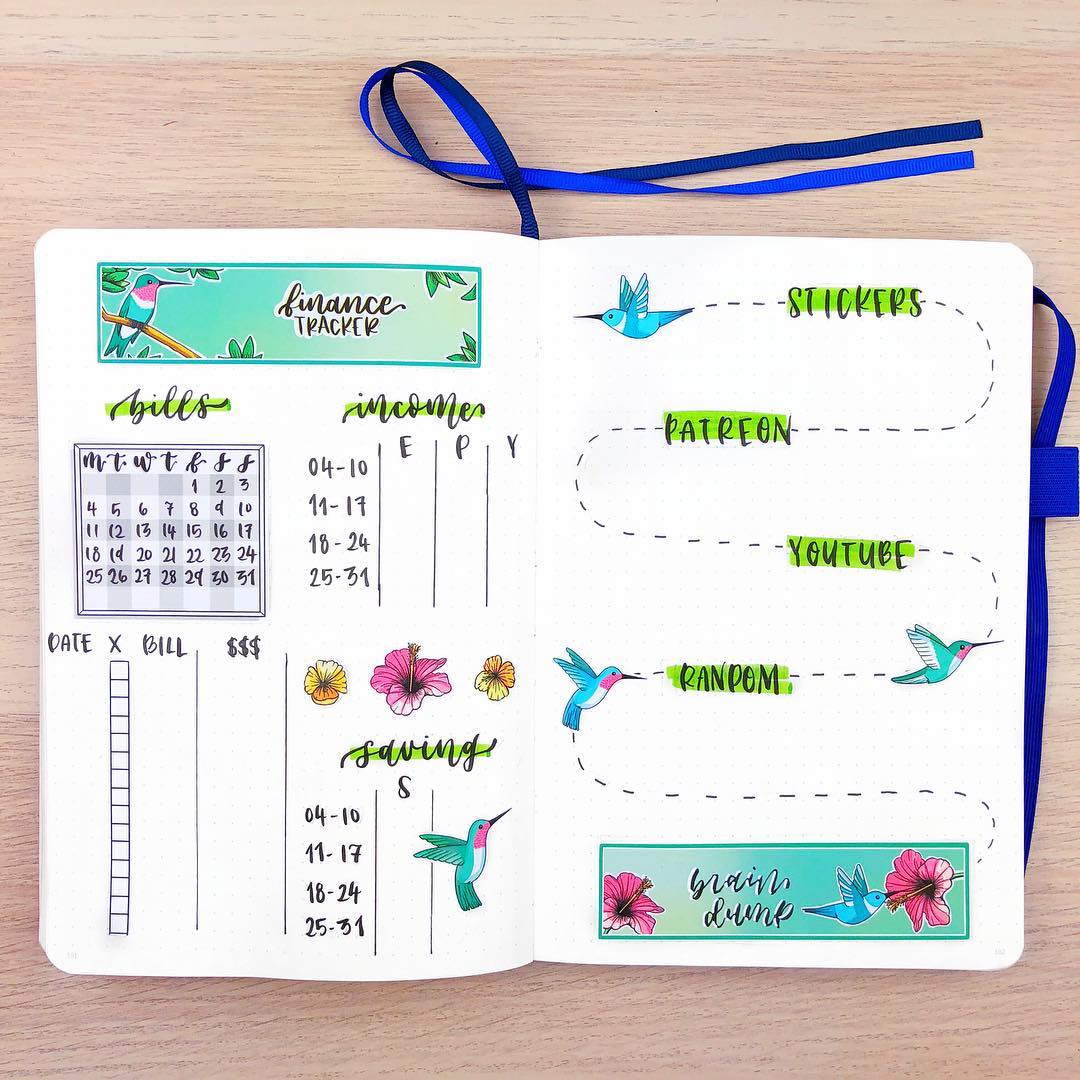
Source: planningwithkay
Adding a finance tracker to your bullet journal spread is an effective and easy way to keep a check on your expenses while ensuring that you stay on budget. Having clear categories of your expenses in one place helps you keep a check on your incomings and outgoings in an organized manner. So do add a finance tracker to your bullet journal to find yourself saving more!
4. Bucket List
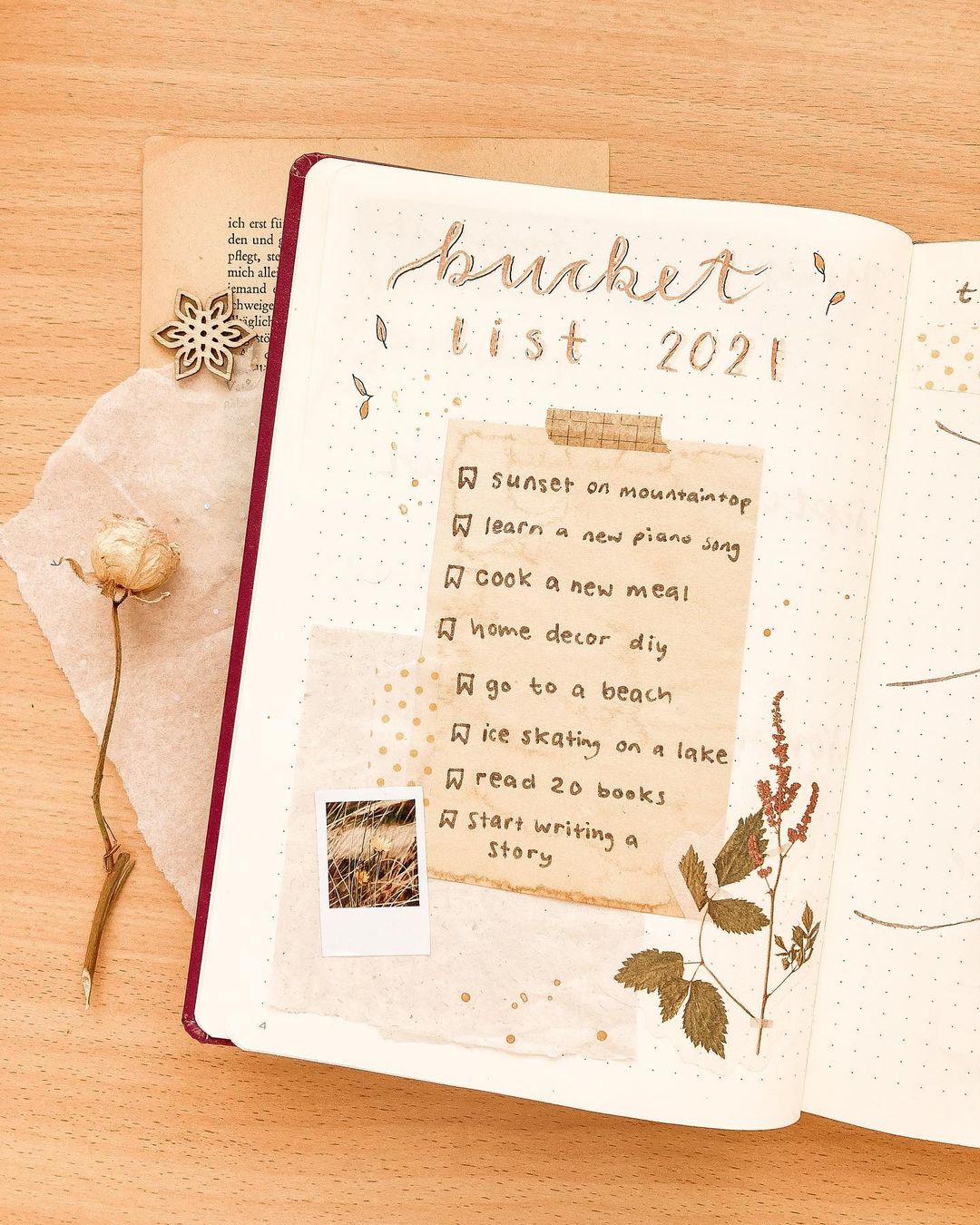
Source: tabea.journal
If you want to work towards and look forward to exciting things each day, adding a bucket list to your bullet journal is a great way to go. It’s a list of not only your goals but also some unique adventures you wish to take during your year!
So, if you have some new destinations to visit this summer or something as simple as trying out new cuisine, list it in your bullet journal bucket list!
5. About Me
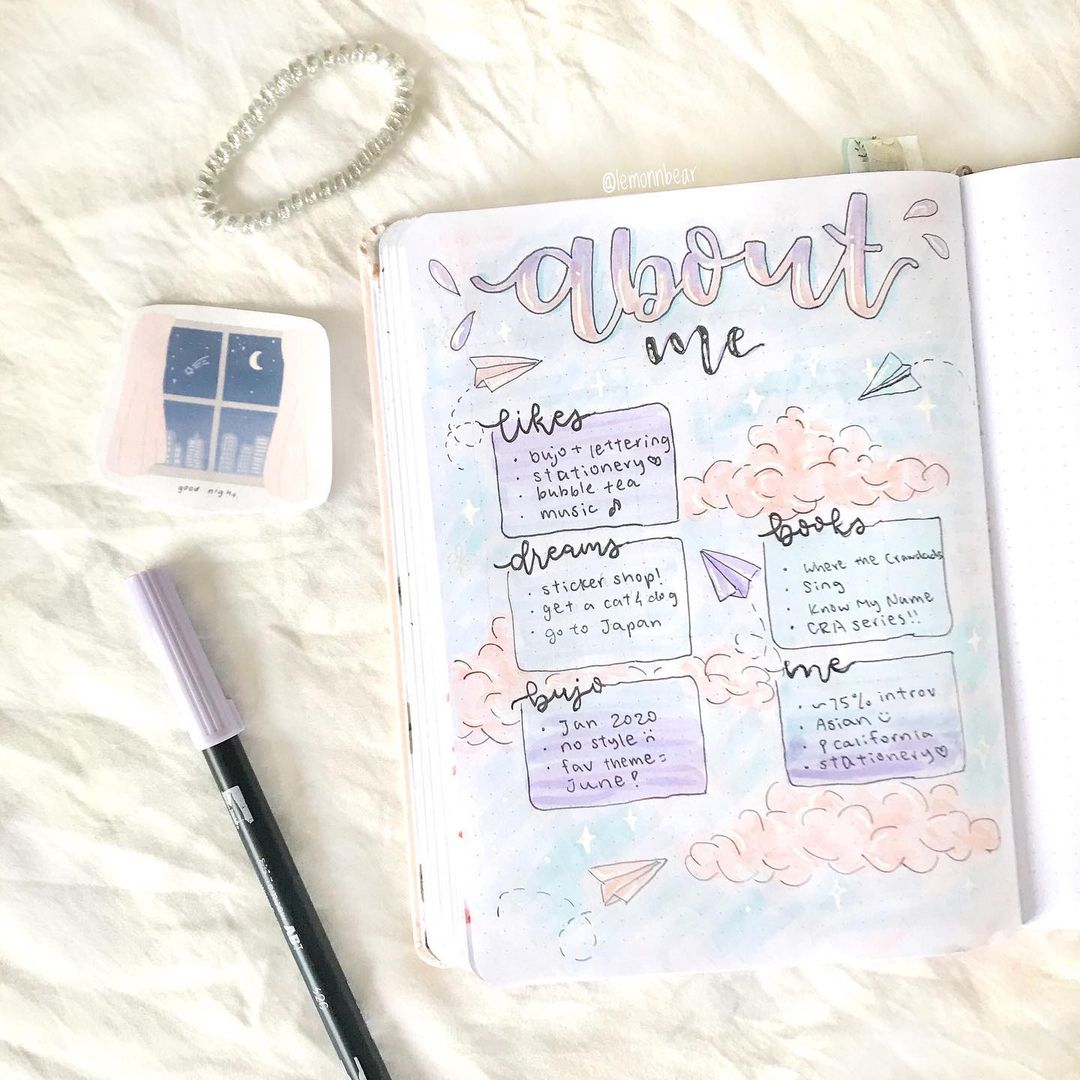
Source: lemonnbear
An “about me” page is a super fun and creative way to do a self-reflection along with highlighting some beautiful memories of your life. It is really pleasing to look back and see who you were and how much you have grown over the months/years.
This spread is a blank space for you to express who you are in any way you love. Some things you can add to your about me page are:
- Likes and dislikes
- Favorites (things, food, places)
- Interests/hobbies (music, books, shows)
- Fun facts about yourself
Make this page as fun and as “You” as possible!
Bullet Journal Setup Ideas
Here are some straightforward and simple bullet journal setup ideas if you are setting up your first bujo, moving to a new notebook, or setting one for the new year!
1. Ideas for your first bullet journal
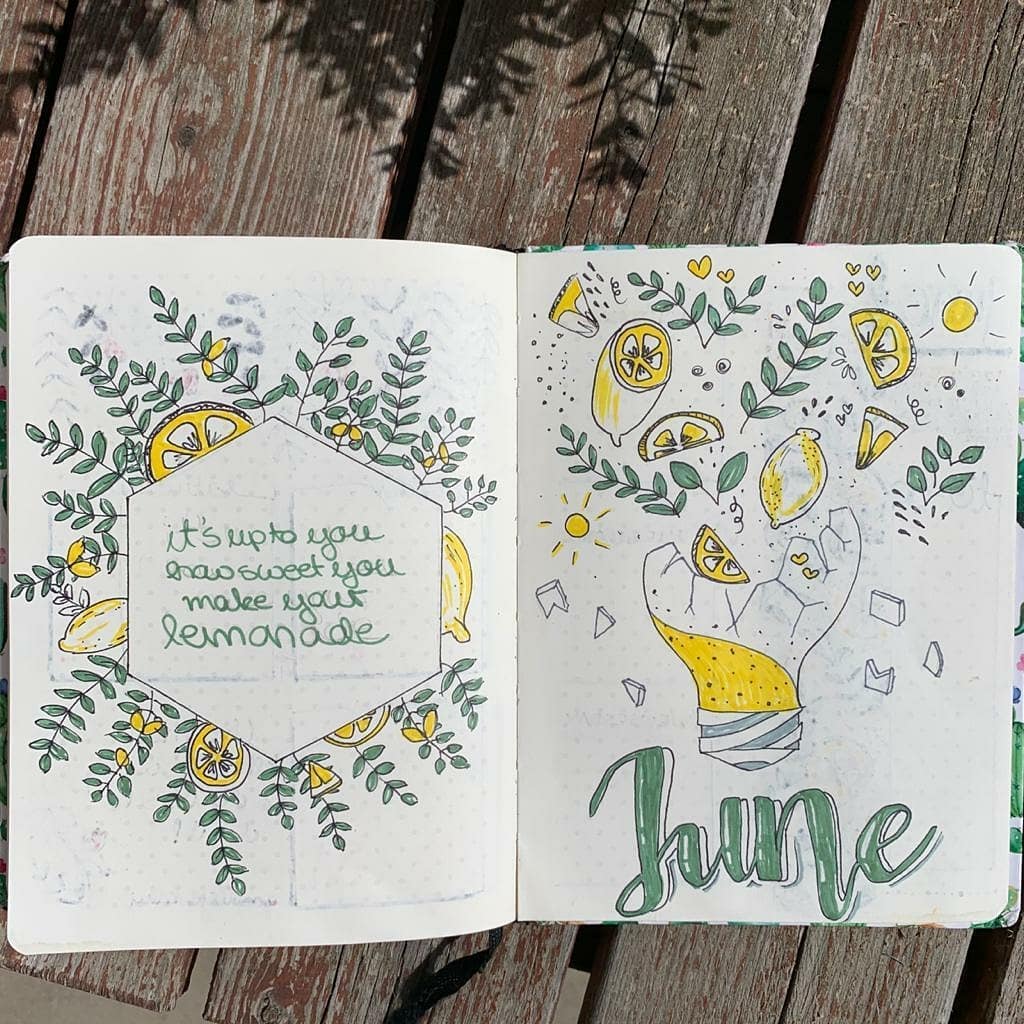
Source: bujo.mayo
If you are setting up your very first bujo, following the basic steps in the previous section is the way to go!
Include a cover, key, index, future logs, monthly and weekly spreads in your bujo. At the same time, you should include some other essentials as well, such as habit and mood trackers, goals tracker, financial log, books to read section, etc.
You can choose different themes for each month or one theme for the entire journal. Remember, less is more, and it’s okay to drop a spread if you don’t use it or it’s not helpful to you.
2. Ideas for starting the new year
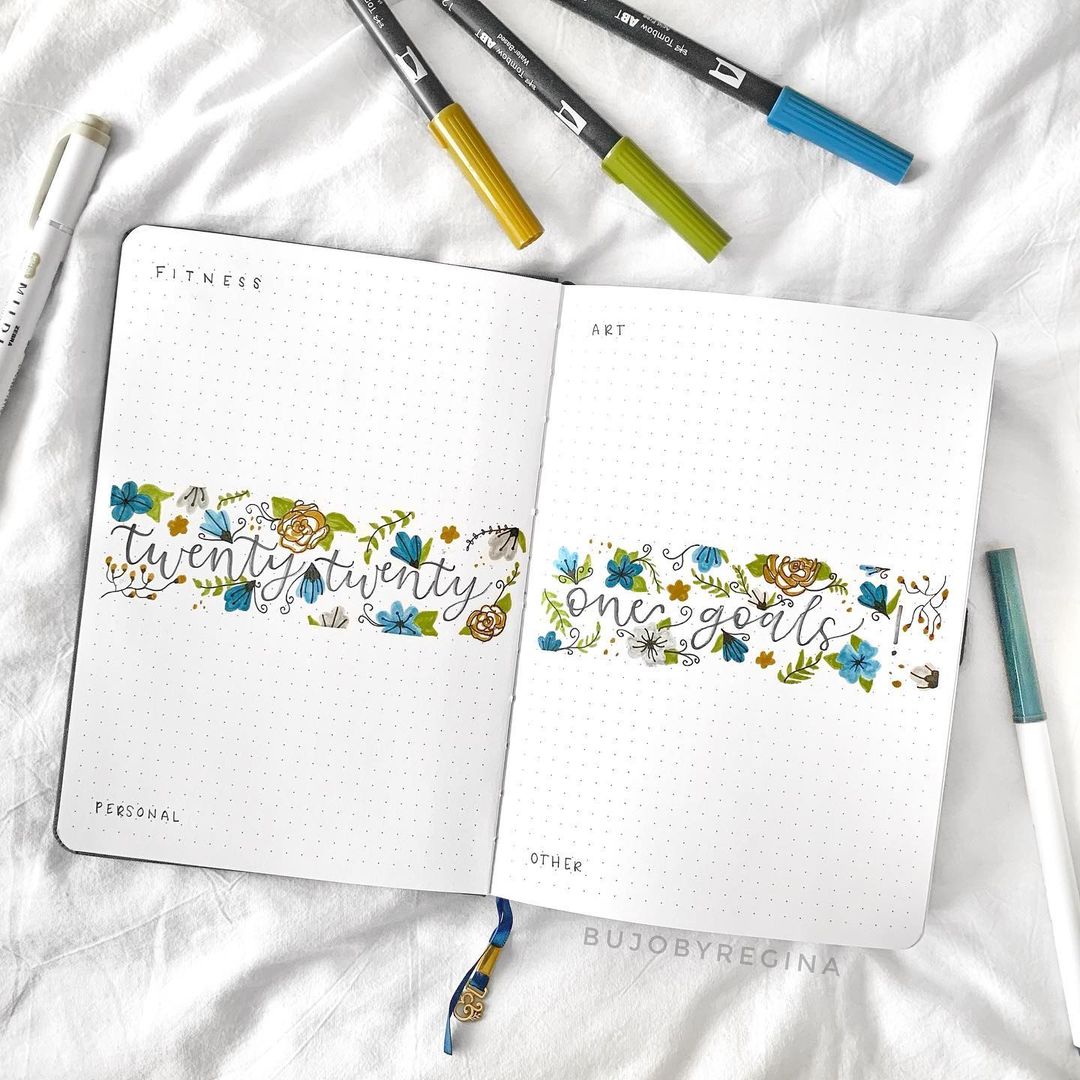
Source: bujobyregina
If you are starting a new journal for the new year, the best way to begin is with a creative and appealing cover page. Welcome the new year with a personalized and artistic touch! Additionally, here are some collections you can add to your new year bullet journal:
- Work of the year
- Looking forward to this year
- Yearly goals
- Yearly trackers/ year at a glance
- Spreads like 21 for 2021
You can also turn any tracker into a yearly one to create a year-end overview for yourself.
3. Ideas for a new journal in the same year
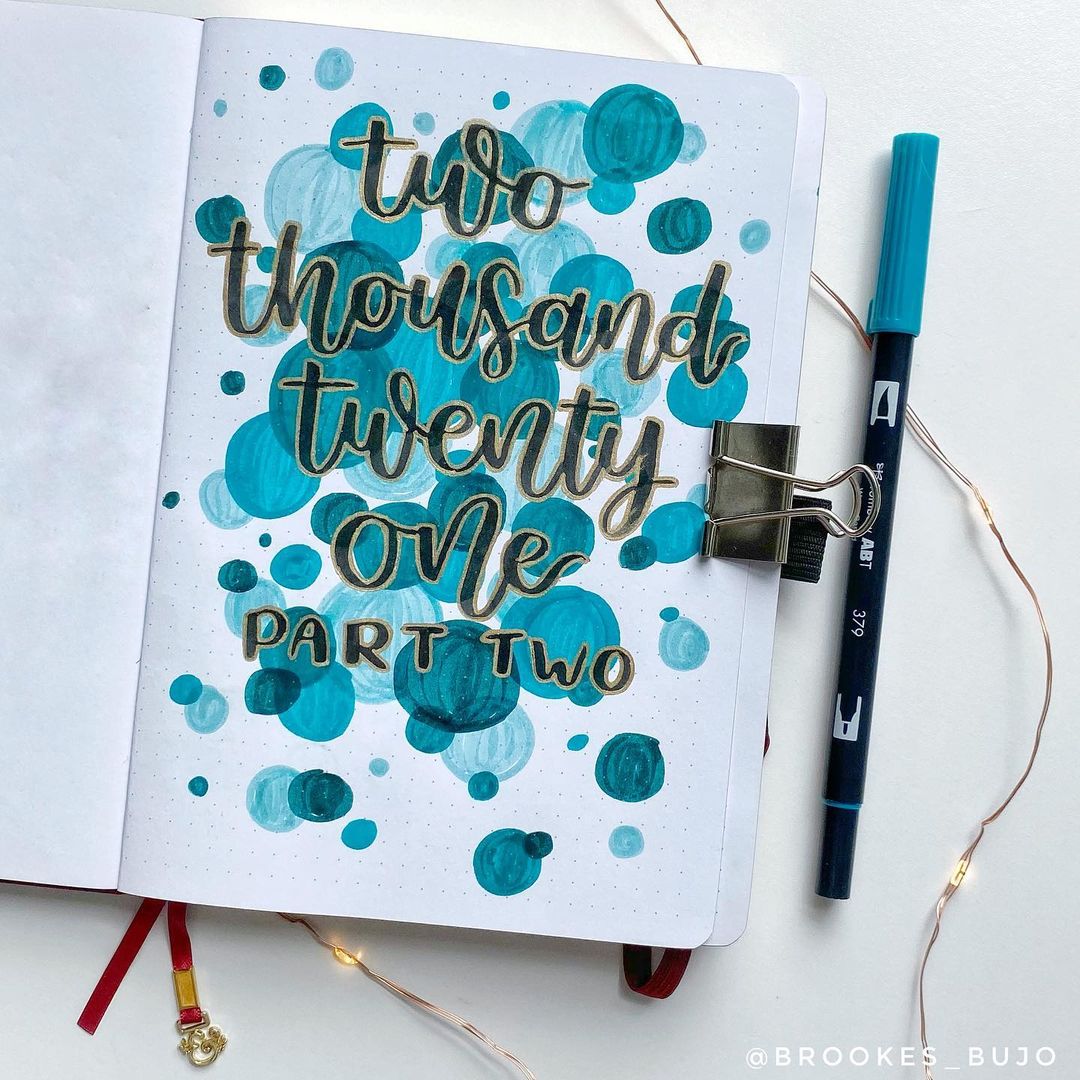
Source: brookes_bujo
If you are moving to a new journal in the same year, the best way to start is by reviewing your previous journal. Filter out the spreads that work for you and the ones that don’t. Consider discontinuing the ones that didn’t.
Think about the things that regularly occur in your daily life and choose spreads that will help organize these tasks. Bullet journaling is a journey of self-discovery, so as we said above, it’s all about trial and error.
You might love something in your previous journal but won’t use it in your new one. So, do read your previous journal before starting a new one. Another great tip is to add a new cover for your second journal of the year. You can use a title like “2021 Part-2”. This allows you to keep track of your work.
Finally, a new notebook means new paper. Add tons of cute swatch pages to find friendly pens for your notebook!
We hope this post was useful and will push you to continue after the first page! If you loved these ideas, you can use the Pin image below to save this article on your ‘Bullet Journaling’ Pinterest board.

